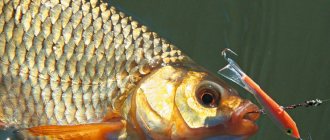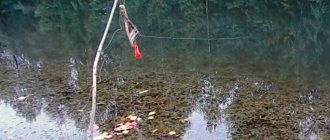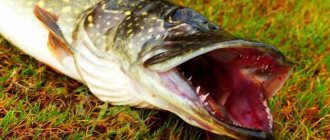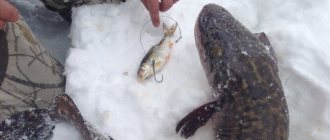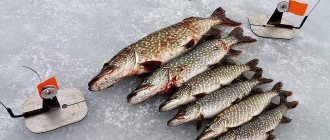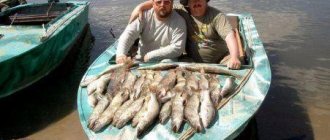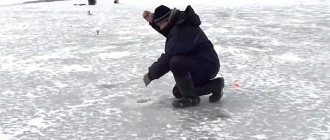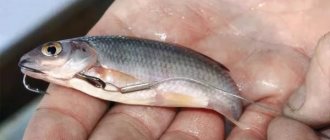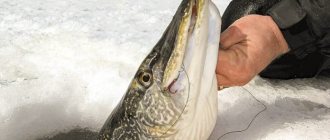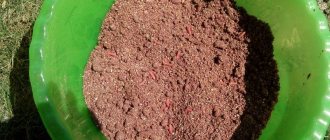What kind of live bait does pike prefer in winter?
In winter, pike behave differently, unlike days when it is warm outside and may not immediately swallow the bait, but keep it in their mouth for some time. The best bait for pike hunting is the fish that is found in the greatest quantity in a particular body of water and which the predator is accustomed to feeding on. For example, you can put any small fish on the girders. But the following fish are considered the best live bait for pike:
- perches;
- crucian carp;
- roach;
- rudd.
By studying the stomach contents of already caught fish, you can find out with almost 100% accuracy what the pike prefers at the moment and, based on this information, make the right choice of live bait.
It is impossible to say unequivocally what kind of baitfish the pike will like at one time or another, since each body of water has its own and each has its own advantages and disadvantages, which are discussed below.
Rotan
Live bait for pike: rotan
Rotan is a picky fish and bites at almost any time of the year. Rotan itself is a predatory fish. Whatever body of water it appears in, this predator displaces its inhabitants and quickly becomes the “owner” of the water territory. Many fishermen have a negative attitude towards rotan precisely for this quality, since it scares away other fish. But at the same time, its survivability and rapid adaptation to the conditions of detention are noted.
Many anglers are interested in whether catching pike with live bait in winter will be successful if they use rotan as live bait. Yes, but with some reservations. Rotan is quite suitable as live bait, but it is not recommended to use it in a reservoir where it did not live, since predators are accustomed to feeding on the fish that are found in their reservoir. If the pike where winter fishing will take place are familiar with this fish, then the catch with this live bait can be excellent. However, you need to make sure that the baited rotan cannot hide under stones or in thickets, since the first thing it tries to do is just that.
Perch
Perch is considered a durable and tenacious fish if you follow the rules when using it as bait. To make the bait last longer, do not thread the line through the gills or lip of the perch. If the gills are damaged, then very soon catching pike with live bait in winter will turn into hunting for dead bait. It should be noted that it is difficult to store caught perch at home, as they quickly die out. It is better to catch perch directly while fishing before fishing for pike.
Gudgeon
Gudgeon is a small but quite catchable bait for pike and is suitable for almost all types of predatory fish. This fish is found mainly in rivers and shallow reservoirs. They can be caught in any weather using a net and small worms. The gudgeon has the ability to dive to the very bottom, which will undoubtedly attract a predator.
About
How to catch live bait?
You can catch live bait directly on the pond using several basic gear:
- Float tackle. To do this, use a short 4 - 4.5 meter lightweight carbon fiber rod with sensitive equipment, including a fishing line 0.12-0.14 mm thick, a float with a weight of up to 1 gram, a small swallow hook No. 18-19 according to the international classification or 2-2.5 according to domestic standards. As a bait, depending on the season, use bloodworms, maggots, mastyrka, and dough.
- Jig tackle. To catch live bait in a pond in winter, use a light balalaika-type fishing rod with a thin line with a cross-section of 0.08-0.1 mm and a small tungsten jig. The nods in this gear are made of lavsan, sensitive, 8-10 cm long. Catch live bait at shallow depths, using small bloodworms as bait. If you are actively biting and using small sports jigs, you can refuse bloodworms.
- Malyavochnik is a lift consisting of a fine mesh sheet measuring 1x1 meter, four arches made of springy wire and a bracket (cross). Fix the wire arcs with one end in the corners of the mesh fabric, and the other in the holes in the bracket. Using a string fixed to a bracket, tie the resulting tackle to a long thick stick.
Malyavochnik
Jig tackle
Float rod
Catch live bait using smallmouths in places where there are a lot of them.
To attract fish, pour the bait mixture into the special pocket at the bottom of the canvas:
- breadcrumbs;
- bran;
- small food bloodworms;
- chopped worms.
Catching pike with dead bait in winter
Experienced fishermen note that in many reservoirs, large pike often prefer dead bait, which lies motionless on the bottom, and do not chase live bait. If the water in the lake is cloudy, then the fish rely mainly on their sense of smell rather than their sight. Hunting for pike using dead bait has become the most preferred method for many anglers recently.
If you catch pike with large live bait, you should attach hooks to different parts of it, since otherwise the pike may eat the bait without reaching the hook.
It should be noted that whole small fish can be used as dead bait, but it is better to divide large fish in half. This method will allow you to quickly attract a predator due to the distribution of internal substances of the dead bait. In this case, it is better to cut the fish diagonally before putting it on the hook.
If a pike has caught a dead bait more than once, it may become suspicious and not swim up to the stationary fish. To do this, some fishermen use a trick by inflating the fish’s head with a syringe in advance or inserting a piece of foam into it. This will keep the head of the bait higher than the body and attract the attention of the predator.
For frozen capelin
Often, instead of live bait, frozen capelin is used for pike. This bait can be prepared in advance and for future use. One of the disadvantages of such bait is its immobility, to which pike rarely react. The movement of frozen live bait can only be achieved by the flow of the river, which is not always the case. However, the smell and unusual taste of capelin still attracts many predators, so many fishermen use this bait in the absence of live fish.
Finding a fishing spot
The main recipe for successful fishing in winter is to find a “pike trail”. Having found the predator's exit points in the reservoir, you can safely hope for bites at these points in the future. It’s not without reason that you can catch up to 5-6 pikes from one hole per day, and the nearby girders are “silent” throughout the entire fishing period.
A sophisticated way of fishing with a large number of girders, provided you are confident in the right place
In winter, pike prefers to be in ambush, watching for passing objects. As soon as prey appears within reach, the predator attacks with lightning speed.
On rivers, the best places for fishing for toothfish will be deep bays, holes under rifts, mill pools, and backwaters above capes. In stagnant bodies of water, fish should be looked for at the boundaries of aquatic vegetation, in channels between the island and the shore, under steep banks, near snags and flooded bushes.
The fastest way to determine the bottom topography is with an echo sounder, but if this body of water will be visited in the future, you can explore it with a spoon or jig.
It is important to note for yourself interesting changes in depth, the presence of obstacles at the bottom, etc. It is useful to watch local fishermen who know exactly not only the cool places, but also the time when the predator comes out. Therefore, in a few hours of fishing, they will catch more fish than other anglers throughout the entire day.
The reel must be fastened at a distance from the surface of the bracket holder no more than 1 cm. It is important that the distance from the bottom edge of the reel to the ice surface is at least 10 cm.
What is the best live bait for pike in winter?
Many anglers believe that the best live bait for pike in winter are perch and roach. This is explained by the fact that pike attack these fish especially aggressively, and on a large river they are often the only live bait suitable for catching a predator.
Sometimes, when attacking a perch and clinging to a hook, a pike may think that these are its spines, and this is also convenient for the fisherman. In addition, the dense scales of the perch force the pike to hold it in its teeth longer without feeling the catch. These live baits are also distinguished by their special survivability at home, so they can be caught several days before pike hunting. In winter, perch can often be found closer to the shore, and roach in shallow water where there is a lot of vegetation.
Ideally, the best live bait for pike in winter is the one with which it is caught in a given body of water at the right time. Which one and what is better can only be determined experimentally.
How to properly mount live bait?
To ensure that the live bait stays securely on the hook, while maintaining its mobility and attractiveness to the predator, use the following methods of hooking it:
- Behind the back - using one of the double or tee hooks, carefully pierce the back of the fish just above the fin located on it. Try not to damage the spine of the baitfish, as this will completely immobilize it.
- For the upper lip - use a hook to carefully pierce the upper lip of the bait fish. The puncture should be as far from the edge as possible - the lips of a small fish are very weak and tender, and if the puncture is too close to the edge, the live bait can easily tear the lip tissue when jerking and come off the hook.
- Through the gills - a metal leash with the double removed, pass one end through the gills of the live bait and out through the mouth, then attach the hook to it. In order to finally fix the live bait, gently pull the leash with the attached double, allowing the hooks to rest their hooks on the edges of the fry’s mouth.
Through the gills
Through the back
For the upper lip
Features of fishing by season: winter, spring, summer and autumn
Spring
In spring, look for pike near spawning grounds in shallow water areas well warmed by the spring sun.
At this time, when fishing at a short distance from the shore, use girders and float rods.
Since the predator is weakened by spawning and is less likely to waste energy on attacking and swallowing large prey, place small live baits.
In the spring, do not forget that in each region there are certain deadlines for the ban on pike fishing.
Summer
Summer heat makes pike sedentary and passive. It feeds mainly in the early morning and late evening, when the water cools down. During the day, most often it stands motionless in thickets of reeds, under the leaves of a water lily, in places where there is shadow or cool springs.
To catch pike in the summer, use girders and mugs, which you leave in selected areas for a long time. Use small live baits. Give preference to crucian carp and roach, which are able to maintain mobility for a long time without falling asleep.
Autumn
In autumn, fishing is the most productive and exciting, when aquatic vegetation begins to die off, the water temperature drops significantly and steadily - this serves as a “signal” for the beginning of the autumn pike feast.
At this time, pike feeds along the shore for 1-1.5 months, and after the first persistent night frosts it begins to move towards the depths.
At the beginning of autumn (September, October), use float tackle, flyers, and as it moves to deeper places, use mugs and spinning rods to catch pike.
You need live bait that is large enough and agile.
Winter
In winter, pike are most active at the end and beginning of the ice fishing season. According to the first ice and the last ice, look for it in shallow areas adjacent to the shore, with a depth of no more than 2 meters, near gullies and thawed patches, in places where streams of melted, oxygen-enriched water flow into the reservoir, near the mouths of streams and small, early-opening from ice, rivers.
In the middle of winter, place vents mainly at great depths, in holes, whirlpools, above edges and channel ditches.
The main and only gear that can be used for ice fishing for pike is a winter girder - bet.
Among live bait, give preference to lively perch and roach, small crucian carp.
Take action!
When fishing for pike in an unfamiliar body of water - a small river with an average current:
In order to replenish the stock of live bait if necessary, take with you a small 3-4 meter float rod
- Use two types of gear - a float rod and a jigging rod. The gear is pre-prepared at home so as not to have to modify it directly on site.
- It is better to use a float rod with a 5-meter fly rod. Assemble the equipment of such a fishing rod from 4.5-5 meters of monofilament fishing line with a cross-section of 0.25-0.3 mm, a large float with a long bright-colored antenna, an olive sinker weighing no more than 8 grams, a metal leash 15-20 cm long, a double or treble hook No. 4-6. Wrap all the equipment on a plastic or wooden reel 20-25 cm long.
- Assemble the equipment of the girders from the same components with the difference that increase the supply of fishing line to 10 meters and do not install a float.
- In order to replenish the stock of live bait if necessary, take with you a small 3-4 meter float rod with light and sensitive equipment or a small fish.
- Having arrived at the place, before starting fishing, as silently as possible and, if possible, without getting very close to the water, walk along the bank of the river and find places where the pike can stand in ambush, waiting for a fish swimming past - this is the border of thickets of aquatic vegetation and clear water, trees fallen across the riverbed, overgrown quiet and shallow backwaters.
- If you didn’t take live bait with you , then if there are feeding places in shallow waters, you can very easily catch it with a small fish or a light float rod.
- After the places have been selected , cast the poles - unwind a fishing line on each of them 5-10 cm long less than the depth in the selected place, fix it in a split on one of the slingshot branches, tie the tackle with twine to a pre-prepared long pole, attach a live bait to the hook and carefully throw it into the water.
- Throw 3-4 girders in this way.
- a float rod with live bait at a distance of at least 15 meters from the last bait.
- Keep an eye on the float rod constantly , and check the rods every few hours.
- Fish for a pike hooked on a fishing rod or bait, taking into account the presence of dangerous spots nearby - snags, dense vegetation. Bring small grass and medium-sized predators to the shore quickly enough and remove them from the water, holding them with your hand under the gills. Tire a large trophy pike on a tight line for some time, then slowly pull it to the shore and put it in a landing net.
- In order to keep a caught pike alive for a long time, place it on a cooch, which you tie with strong twine to a stake or tree driven into the shore and lower it to a depth sufficient for normal breathing of the fish.
